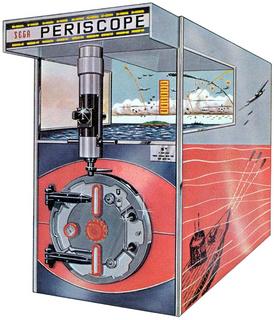Last summer, I had the opportunity to spend some time at the magnificent arcade at the Cedar Point amusement park in Sandusky, Ohio. You may recall a video walkthrough I made of the experience. One of my personal highlights from the arcade visit was seeing all the old electromechanical games that were on the floor. These games were the direct predecessors to video games, and though they are primitive from a certain perspective, the intricate mechanisms and ingenious gameplay methods they exemplify are wonderful in their own right.
One of the most popular electromechanical (EM) games of the late 60s and early 70s was Periscope. This gem was developed by a little company that you might possibly have heard of: Sega. Decades before the Genesis and Sonic, Sega entered the gaming business with an EM game that put players in the role of a submarine gunner, launching torpedoes at ships. Their first game, Periscope, was a smash hit across the globe. It was the first EM game to cost a quarter; this of course became the standard for arcade games for many years.

Periscope had a striking presence in the arcade. It was huge, with open glass sides that allowed spectators to watch the action. A realistic periscope was the controller, with a fire button on the right handle. Lights and electronic sounds, as well as the sweet cabinet art, added to the appeal. As with most successes, Periscope had a large influence on the arcade industry as a whole.
By 1976, the first true video games were in arcades across the world. But alongside Pong, Racer, and Gun Fight, the old EM games were still attracting interest. In many ways, the EM games were superior to the primitive capabilities of video games from the era. Midway, undoubtedly inspired by Periscope, combined many of that earlier game’s features with a video screen, and Seawolf was born.

Sharing its name with a naval defense missile, Seawolf was a hybrid game of sorts. Though it was technically a video game, many of its features were EM in origin. A fancy cabinet, dominated by a periscope controller, drew the prospective player’s eye. Lights in the periscope gave feedback on hits and informed gunners about missiles remaining. The game screen itself was a simple black and white field, covered by a blue overlay to give a more ocean-like appearance. Players shot torpedoes at ships travelling on the surface, aiming for a high score in the time limit. The integration of EM and video components made Seawolf a modest success, selling over 10,000 units.
